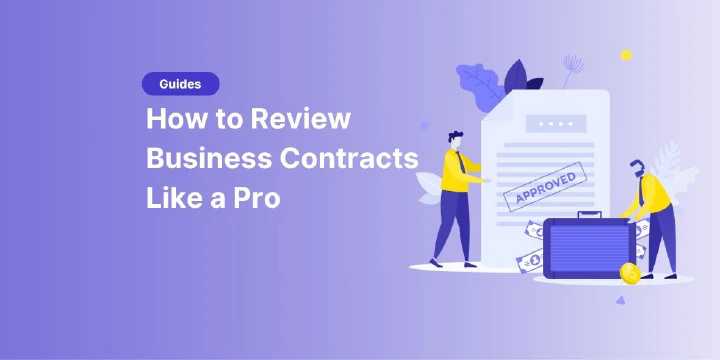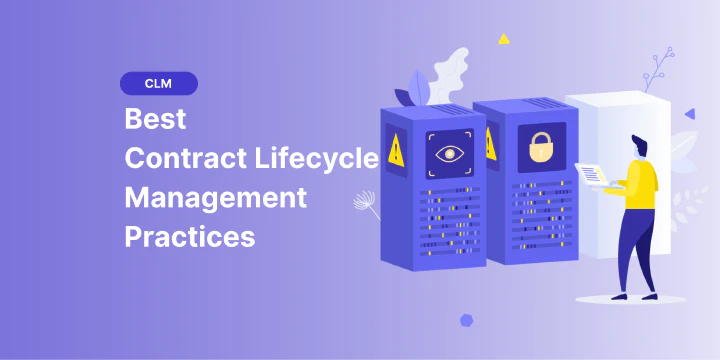The 8 phases of contract management
Effective contract management can essentially be divided into eight phases. The following article provides an overview of these phases and outlines the lifecycle of a typical contract.

1. Contract Inquiry
The contract lifecycle usually begins with a request for the creation of a contract by one party. A contract request contains all relevant information related to the business at hand, such as the parties involved and their contact information, a description of the product or service being offered, pricing details, contract start and end dates, and any other basic framework related to the contract at hand.
While in the past this business process was often mapped using printed request forms, modern contract management software offers many opportunities to increase efficiency here. Software helps to seamlessly document the lifecycle of a contract from the very beginning and thus forms the basis for successful contract management.
2. contract creation
Contract creation is the process of creating a contract based on the information gathered in the inquiry phase. During this phase, the contracting parties develop their contract terms.
Contract creation is one of the most important phases of the contract lifecycle (CLM/Contract Lifecycle Management) because it sets the direction for future contract performance and compliance. A poorly written contract or a contract that contains ambiguous clauses can lead to unnecessary legal problems that may require a lot of effort to resolve.
Again, the use of contract automation software makes it much easier for users to create contracts. A library of templates, which are automatically populated with content from linked databases, as well as pre-approved clauses or automated feedback processes, allow for faster and more transparent creation of complex contracts.
3 Contract processing
Contract processing consists of contract review, contract negotiation, and contract approval. This trio requires constant collaboration between all representatives of the parties in a contractual agreement.
Modern contract management software today enables intuitive, transparent and efficient collaborative work on a contract here. Features such as redlining and ongoing version comparisons greatly facilitate work at this stage.
4. contract signing
Before a contract becomes binding, the parties must sign the agreement. They can do this digitally or on paper, and it may even require multiple approvals within an organization.
Contract management software can greatly simplify the process via dynamic eSignature capabilities and predefined workflows. Digital signatures dramatically improve your time-to-signature, which positively impacts your close rate. There is no need to manually print, sign, and scan the contract, as everything is included digitally in one step.
5. contract tracking and compliance.
This is often the longest phase in terms of time and encompasses the entire contract period. In this phase, it is essential that the contracting parties keep track of their contractual obligations.
Contract tracking is essential to ensure that each party complies with the contractually fixed terms. It reduces all forms of risk and provides the basis for auditing contracts. Since manual audits are prone to errors, it is advisable to use CLM software to quickly gain relevant insights and generate analytics. During contract tracking, you can review the success of your agreement and determine whether you need to renegotiate, renew or terminate it.
Often, in times of DSGVO (Data Protection Regulation), this part of contract management cannot be done without software. Contract management software helps keep track of contracts and sorts them by tags, financial value, parties, or business territory. A central secure place to store existing contracts can also often only be ensured by software. Using modern technologies, contracts are securely stored in the cloud and available to authorized parties worldwide.
6. end of contract
The contract ends on the agreed date when all contract conditions have been fulfilled, including performance, payment, etc. At that time, neither party is obligated to perform the contract any longer. They may then terminate the contract or initiate an extension.
7. contract extension
After the contract expires, the parties may initiate an extension to enter into another contract with the same or updated terms. A CLM system notifies all affected parties and the process begins again.
8. contract analysis
Contract analysis is the process of extracting and analyzing data from existing digital contracts. Through this process, you can identify the most favorable terms in your contract, determine if the contract has been breached, and gain insights for future contracts.
Contract analysis capabilities include extracting parties, dates, payment terms, termination clauses, indemnification clauses, and liability limitations. The extracted data can then be analyzed using a variety of analytical tools, including word clouds and other forms of text visualization. You can analyze your contracts manually if they are only available in PDF or Word format, but it’s much easier if your contracts are stored electronically in a database - where they can be easily searched - or in a CLM system that includes automated extraction tools.
Contract analysis also includes monitoring performance metrics on both sides of the contract. These metrics help determine whether or not either party is in violation of the terms of the contract. In addition to monitoring performance metrics, it is also important to ensure that all required contracts are stored securely and that access to these contracts is limited to those who have proper authorization.
Please keep in mind that none of the content on our blog should be considered legal advice. We understand the complexities and nuances of legal matters, and as much as we strive to ensure our information is accurate and useful, it cannot replace the personalized advice of a qualified legal professional.

Table of contents
Want product news and updates? Sign up for our newsletter.
Other posts in Contract-Management

How to Review Business Contracts Like a Pro in 2025
When it comes to business contracts, what you don’t catch can hurt you. That’s why reviewing a business …

10 Best Contract Lifecycle Management Practices in 2025
Remember when closing a deal meant printing five copies, couriering them for “wet” signatures, then hunting …

How to Write a Contract Proposal (+Examples)
Imagine a freelance marketing consultant gearing up to pitch their services to a mid-sized tech company. …
Contracts can be enjoyable. Get started with fynk today.
Companies using fynk's contract management software get work done faster than ever before. Ready to give valuable time back to your team?
Schedule demo

